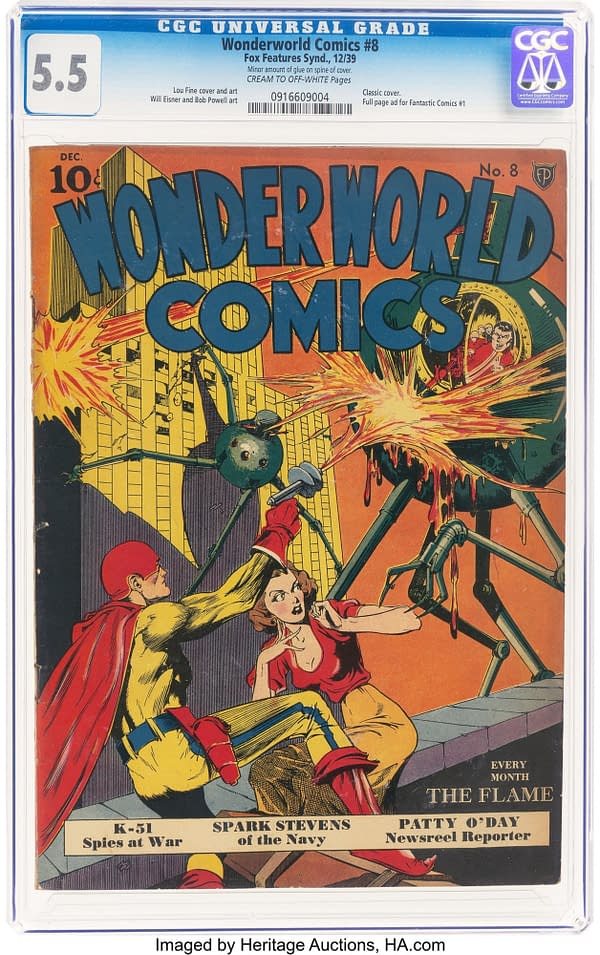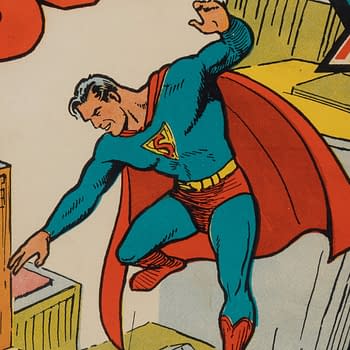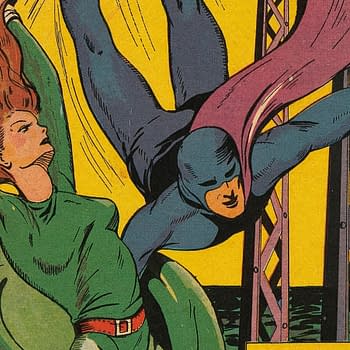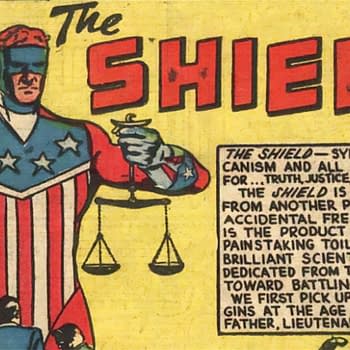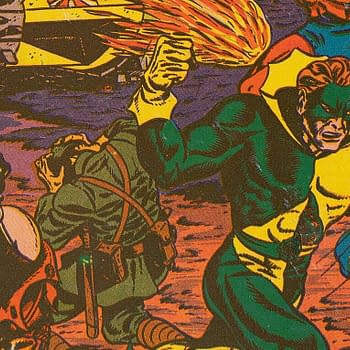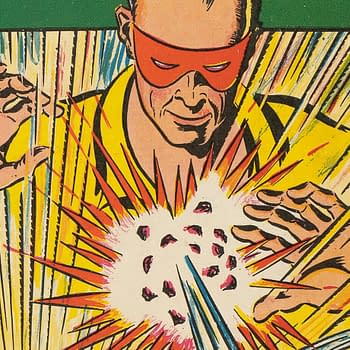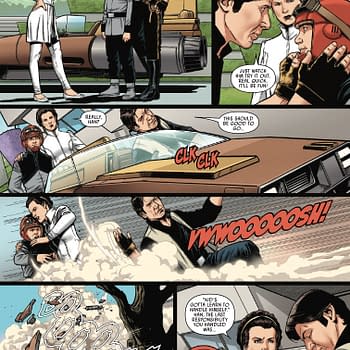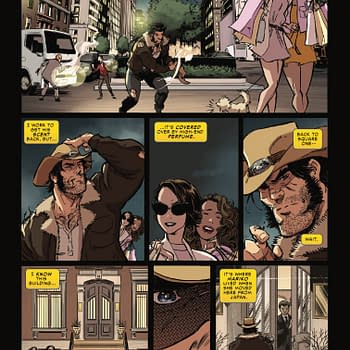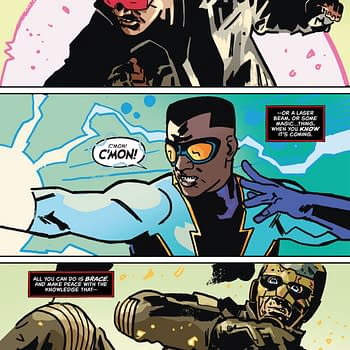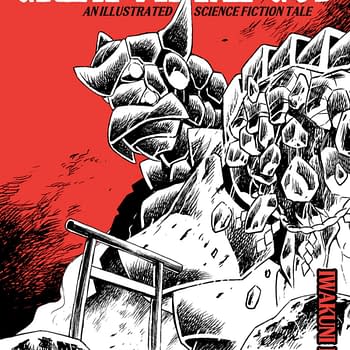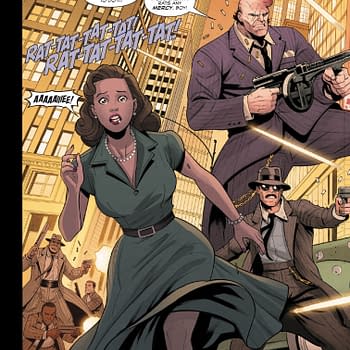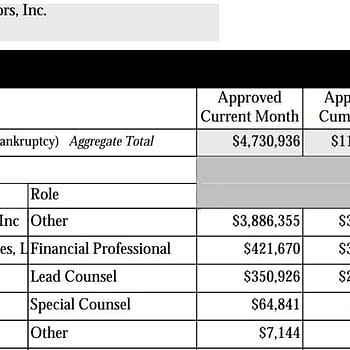Posted in: Comics, Heritage Sponsored, Vintage Paper | Tagged: Fox Feature Syndicate, lou fine, victor fox, will eisner
Wonderworld Comics #8 and "The Age of Atomic Power", Up for Auction
With a Lou Fine cover likely inspired by War of the Worlds and a Will Eisner plot inspired by headlines of its day, Wonderworld Comics #8 is an underappreciated classic.
Article Summary
- Lou Fine's Wonderworld Comics #8 cover draws inspiration from War of the Worlds and 1939 atomic age headlines
- Will Eisner's story introduces atomic power fears to comics just months after the discovery of nuclear fission
- The Flame predates Marvel's Human Torch, evolving from limited flame powers to full-fledged fiery abilities
- Fox Features Syndicate comics sometimes mirrored contemporary science fiction and cultural trends of the late 1930s
The cover of Wonderworld Comics #8 by Lou Fine is somehow an underappreciated classic among Golden Age science fiction comics. In the foreground, The Flame saves a terrified woman from a monstrous, multi-limbed mechanical quadruped that looms over them, its metallic tentacles reaching menacingly. In the background, another mechanical monstrosity scales a building like a spider in a scene of technological horror. To anyone browsing a newsstand in late 1939, this imagery might have felt a little familiar. The mechanical creatures and the scene of invasion seem to be a visual echo of a significant media event from the prior year, Orson Welles's War of the Worlds radio broadcast (perhaps with "quadrupods" here and not tripods), which was still making news. One particular King Features syndicated piece that July had even referenced War of the Worlds in the context of rising fears over the capability of atomic energy. Wonderworld Comics #8 was probably in production a short time later, with a cover that brought those fears to comics.

Of course, this would not have been the only time that Fox Features Syndicate comics were inspired by then-recent pop culture touchstones. Most famously, DC Comics sued Fox earlier that year for copyright infringement over the character Wonder Man's similarities to Superman in Wonder Comics #1. In a more obscure example the next year, Weird Comics #5's Dr. Mortal shinking man cover likely inspired by the science fiction-horror film Dr. Cyclops, which was marketed to be a big-budget blockbuster for that year, from producer Merian C. Cooper and director Ernest B. Schoedsack, both of King Kong fame, and considered the first science fiction film released in full Technicolor.
While such inspirations are hardly unusual in comics or any other storytelling medium, Fox Features Syndicate founder Victor Fox was one of the most notorious publishers of the Golden Age of comic books — and that's saying something. Through lawsuits over copying characters from other publishers, two bankruptcies, and tangling with the War Production Board over violating paper quotas, Fox was a man who wasn't afraid to get in the mud to achieve success. Somehow through all that, he put out some excellent and historically important comic books by foundationally important writers and artists. Wonderworld Comics is an example of Fox Feature Syndicate at its best.
Given Fox's reputation, it is often assumed that the Flame is little more than a Human Torch rip-off, but… yes and no. The character first appeared in Wonderworld Comics #3, months in advance of the Human Torch's debut in Marvel Comics #1. However, his Flame-based powers were limited to being able to sort of materialize himself within a flame in his initial appearances. In Wonderworld Comics #11, a few months after the debut of the Human Torch in Marvel Comics #1, the Flame's origin is told for the first time. It was a not uncommon type of saga in which he ends up in a Buddhist monastery as a child and learns ways of advanced science, magic, and physical combat — and most importantly, control over flame. That control is seemingly demonstrated for the first time in Wonderworld Comics #14, where he exhibits one of his go-to moves of this period, shooting a stream of flame from his gun and then walking on that stream to get where he needs to go. The next month, The Flame #1 expands upon the origin from Wonderworld Comics #11 a little more, while bringing all of the flame-power elements used up to that time together. Eventually, without further explanation in Wonderworld #22 and The Flame #4, he is shown being able to spontaneously burst into flame himself, which allows him to fly.
The narrative of the Flame story by Will Eisner and Lou Fine revolves around a scientist, Dr. Harvey, who discovers how to "liberate atomic energy" and declaris that this revolutionary discovery will usher in a new "age of atomic power." An assistant steals the secret, which is then used to power animated machines that terrorize the city. In the real world, the science of nuclear fission was new, and its potential was a closely guarded secret. Albert Einstein's famous letter warning President Franklin D. Roosevelt about the possibility of an atomic bomb was sent in August 1939, and the secret Advisory Committee on Uranium was formed on October 21, 1939, just before this comic hit the newsstands. Even so, the discovery of nuclear fission had been announced to the scientific community in late 1938 and early 1939, creating great excitement and fear. Both of those feelings on the matter had made their way to the mainstream public by mid-1939, likely directly inspiring the feature story of Wonderworld Comics #8 years before the first usage of the atomic bomb.
Wonderworld Comics #8 hit newsstands around the same time as Marvel Mystery Comics #2 and Detective Comics #34. There are only 44 entries for the issue on the CGC Census, and only 8 copies graded higher than this CGC 5.5. This issue is arguably the best of the Wonderworld Comics covers, and there's a Wonderworld Comics #8 (Fox, 1939) CGC FN- 5.5 Cream to off-white pages copy up for auction in the 2025 September 18 Golden Age Comics Century Showcase Auction II at Heritage Auctions.
